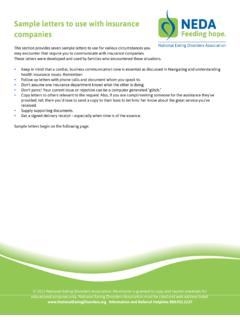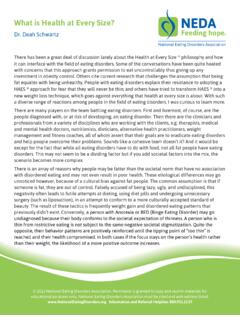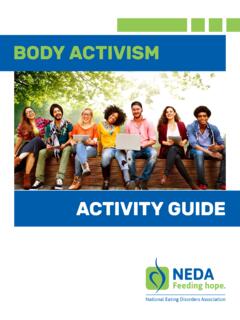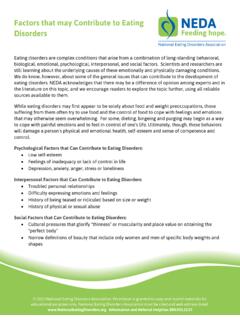Transcription of Parent - National Eating Disorders Association
1 ParentTOOLKITPage | 2 NEDA TOOLKIT for ParentsTable of ContentsI. The NEDA Educational Toolkits Story ..3II. About Eating Disorders ..5 Eating Disorder Myths 6 Risk Factors for Eating Disorders 10 Emotional and Behavioral Signs of an Eating Disorder 11 Physical Signs and Symptoms of an Eating Disorder 12 Eating Disorder Statistics 14 III. Supporting a Loved One ..16 Encouraging a Loved One to Seek Help 17 Encouraging Your Child to Seek Treatment 18 First Steps to Getting Help 20 How to Support a Loved One with an Eating Disorder 21 How to Talk to a Loved One about an Eating Disorder 22 Talking to Young Children About Eating Disorders 23 When Your Loved One is Over 18 and Refusing Treatment 24IV.
2 Treatment Information ..26 Level of Care Guidelines for Patients 27 Finding Treatment for Your Loved One s Eating Disorder 30 Questions to Ask a Treatment Provider Privately 36 Selecting a Treatment Center for Your Loved One 37 Treatment Glossary 40V. insurance Issues ..43 Understanding insurance Issues for Eating Disorders Treatment 44 Obtaining insurance Benefits for Higher Levels of Care 47 Common Reasons for Denying Further Care 48 Steps to Take When Determining Coverage Allowances 49 Strategies for Providers for Fighting insurance Denial 50 How to Manage an Appeals Process 52 Sample Letters to Use with insurance Companies 53 Other Steps for Loved Ones 63VI.
3 Making Sense of Neuroscience ..64 Appetite 65 Body Image 67 Neurotransmitters 69 Reward 72 Temperament and Personality 74 Page | 3 NEDA TOOLKIT for ParentsThe Background When a friend or family member is diagnosed with an Eating disorder, it s often terrifying and confusing. How did this happen to our family? Is my child going to be okay? Will my friend ever get better? It s all too easy to get tangled in these questions and become mentally trapped, paralyzed with fear and unable to help yourself or your loved your loved one recover from an Eating disorder will take a lot of work from everyone involved.
4 As with many jobs, having the right tools is crucial. Eating Disorders have a steep learning curve, and you and your family member will need to develop lots of tools to work towards NEDA Parent Toolkit was created to provide some of these tools that can be used in critical moments in your search for help, hope and healing. As one Parent told us, this toolkit was exactly the resource we needed when we started the journey for our family, we needed real resources, reassurance that we were not the only family with the challenge and that there would be light at the end of that tunnel.
5 The toolkits are designed to put crucial information at your fingertips and offer your family a range of ideas on how to best help your loved one recover from an Eating disorder. Some of the questions you might find answered in the following pages are: What are Eating Disorders and how are they treated? What are signs of a medical or psychiatric emergency? How do I deal with school issues while my child is ill? What types of treatment are available? How do I know what type of treatment will work best? How do I get my insurance company to cover my loved one s treatment?
6 The NEDA Educational Toolkits StoryOf course, no toolkit, no matter how thorough, could possibly address the diverse range of issues that are unique to each individual and family. Instead, our goal is to provide a comprehensive overview of Eating Disorders and treatment in one easy-to-use document. We have provided resources for more in-depth information that may address these unique goal is to maintain the usefulness of the toolkits by treating them as ever-evolving documents. We will continue reviewing and revising them, adding the most up-to-date research and information.
7 NEDA s clinical advisors will be the primary reviewers, along with other experts and stakeholders invited by NEDA, including families and members of professional organizations that will be disseminating the toolkits. If you have suggestions for improvement, we want to hear from you!A Brief History of the ToolkitsIn September 2007 the Board of Directors of NEDA officially approved the organization s new strategic priorities, listing educational toolkits as a new NEDA priority fitting the new mission: To support those affected by Eating Disorders and be a catalyst for prevention, cures, and access to quality care.
8 Educational Toolkits were created to strengthen NEDA s online material offerings and provide vital information to targeted audiences. A list of audiences was prioritized by the board and serves as a reference for ongoing materials and toolkit toolkits were initially developed to combine existing information with new findings to create a complete package to assist individuals in their search for information and help. They were meant to provide guidance, not create standards of care, and would be based on the best available information at the time of | 4 NEDA TOOLKIT for ParentsThe first toolkits were created with the assistance of the ECRI Institute, an organization known for its ability to translate complex healthcare research into accessible, usable information.
9 After developing the first draft of the Parent Toolkit, NEDA and ECRI convened several focus groups of parents to review the document. Together with input from NEDA s Board of Directors and other Eating Disorders experts, the first Parent Toolkit was released in 2008. A revised Parent Toolkit was released two years the continuing advances in Eating disorder research and treatment, NEDA realized that another more significant revision was needed. Again, the input of parents, former Eating disorder sufferers, and Eating disorder experts was used to further refine the draft document.
10 In 2015, version of the Parent Toolkit was are currently seeking funding for the ongoing development of toolkits, as well as distribution and marketing. If you or anyone you know may be interested in contributing to, sponsoring or providing a grant to support these efforts, please be sure to contact our Development Office at 212-575-6200, ext. 307; hope you ll find these toolkits useful and will share this resource with | 5 NEDA TOOLKIT for ParentsAbout Eating DisordersPage | 6 NEDA TOOLKIT for ParentsEating Disorder MythsEven for professionals who have been treating them for years, Eating Disorders can be baffling and confusing illnesses.




